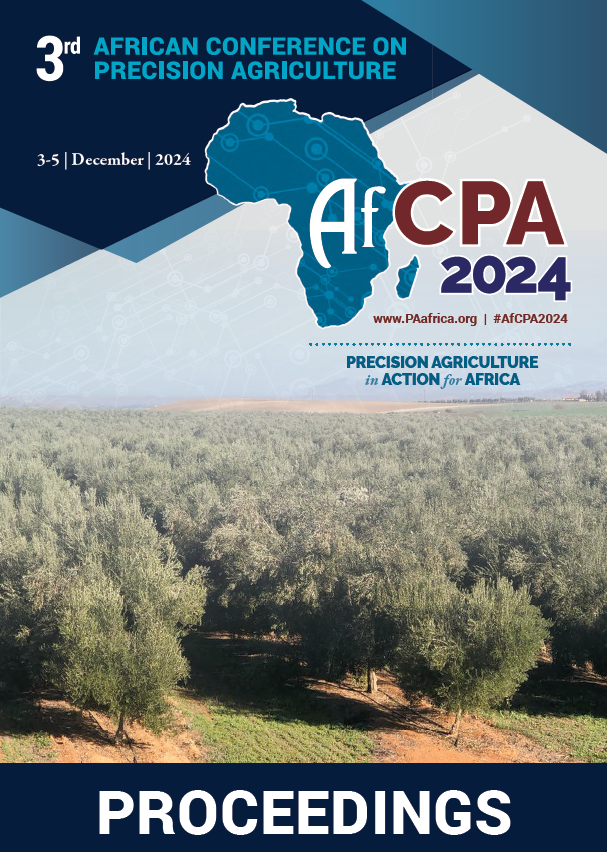Download the Conference Proceedings
Proceedings
Authors
| Filter results8 paper(s) found. |
|---|
1. Crop water requirements, biomass and grain yields estimation for Sulla (Hedysarum coronarium L.) using cropwat in semi-arid regions of TunisiaDwindling water resources and increasing food requirements require greater efficiency in water use, both in rainfed and in irrigated agriculture. Regulated deficit irrigation provides a means of reducing water consumption while minimizing adverse effects on yield. With the current water shortage in Africa improving crop water use is vital especially in the arid and semi-arid regions. Models can play a useful role in developing practical recommendations for optimizing crop production under... R. Hajri, M. Rezghui, M. Mechri, M. ben younes |
2. Potential precision agriculture practices for higher fruit and vegetable production in West Africa: A ReviewDuring the last decades, efforts have been made to increase the yield and the quality of major fruits and vegetables but still, farmers mainly those in West African countries are struggling to close the yield gap. Precision agriculture has been reported in most developed countries as a set of tools integrating information and technologies for efficient crop production. Over the decades, scholars have been skeptical about the development and implementation of precision agriculture in West Africa... V. Fassinou hotegni, L.W. Azonhoumon, E.G. Achigan-dako |
3. Assessment of Nitrogen and Phosphorus Content (NP) in Citrus Trees Using UAV-imagery Derived Vegetation Indices and Machine Learning AlgorithmsMonitoring nutrient status of citrus trees is fundamental to ensure optimum fruit yield and quality. However, this task is traditionally time-consuming and laborious. Unmanned Aerial Vehicles (UAVs), with their high temporal and spatial resolution imagery, are demonstrating a great potential to substitute traditional methods in assessing nutrient status of several crops, including citrus. In this study, we evaluated the performance of vegetation indices (VIs) derived from UAV multispectral images... Z. Abail, H. Benaouda, M. Chikhaoui, H. Benyahia, O. Iben halima, M. Baraka, A. Douaik, H. Iaaich, A. Zouahri, F. Omari |
4. Engaging Stakeholders in Precision Agriculture Toolbox Conception: Case of Cowpea Atlas Platform Establishment in Benin RepublicCowpea [(Vigna Unguiculata (L.) Walpers] is among the most preferred and consumed legumes in West Africa and grown by many smallholder farmers. The crop has huge potential, is easy to grow and constitute a source of income of many actors involved in different value chains. Unfortunately, despite many interventions which aimed at promoting the crop in West Africa mainly Benin, areas under cowpea crop decrease over the years along with the loss of cowpea-based products. Such problem is... N.V. Fassinou hotegni, Y.L. Godonou, L.M. Gnanglè, O.N. Coulibaly, E.G. Achigan-dako |
5. Optimizing Water Use Efficiency in Flood Irrigation Systems in UgandaThere is growing demand for water across different sectors of production. Yet the extent of water wastage to furnish inefficient irrigation systems especially in flood irrigated rice systems, is not known. In developing countries and in Uganda particularly, most irrigation scheduling in the irrigation schemes is based on rotational system rather than crop water needs. In Doho Rice Irrigation Scheme (DRIS) in eastern Uganda for example, farmers’ plots receive up to 50mm ponding of irrigation... P. Onen, E. Opolot, G. Olupot, G. Aguttu |
6. Soil Moisture Sensing for Increased Water Use Efficiency and Crop Yields in Furrow Irrigated Systems: a Case of Mubuku Irrigation Scheme in UgandaWater and nutrient use efficiencies remain low in most of the irrigated systems in developing countries, undermining crop productivity in these areas. This is partly due to lack of precise and site-specific information to guide irrigation scheduling. In most cases information on soil properties and crop water requirements is lacking and thus irrigation scheduling is done on rotational basis whether the crop needs water or not. Consequently, the amount of water stored in soil root zone for crop... E. Opolot, D. Besigye, P. Musinguzi, I.N. Alou, T.A. Basamba, G. Olupot |
7. A Synopsis of Water and Nutrient Requirements of Hass Avocado for Uganda and Sub-saharan Africa PractitionersHass avocado production is increasing in Uganda and sub-Saharan Africa (SSA) to tap into the lucrative market especially in Western Europe, China, Japan, and Russia. However, there is limited information about its water and nutrient requirements in end-user-friendly formats especially in Uganda and SSA. We consolidated the scanty information about water and nutrient requirements of Hass avocado and made necessary recalculations and unit conversions to aid meaningful uptake of the information by... P.C. Odong, G. Olupot, T.L. Odong, A. Mwije, P. Musinguzi, I.N. Alou, T.A. Basamba, P. Ebanyat, E. Opolot |
8. Capacity Building of African Young Scientists in Precision Agriculture Through Cross Regional Academic MobilityClimate change is one of the main problems affecting food and nutrition globally, particularly in sub-Saharan Africa. Adapting to and/or mitigating climate change in the agri-food sector requires merging information technologies, genetic innovations, and sustainable farming practices to empower the agricultural youth sector to create effective and locally adapted solutions. Precision Agriculture applied to crops (PAAC), has been advocated as a strategic solution to mitigate/adapt agriculture at... K. Frimpong, V. Fassinou hotegni, A. Karangwa, A. Manyatsi, M. Amri, D. Cammarano, C. Lesueur, J. Taylor, S. Phillips, E.G. Achigan-dako, G. Houessou, O. Linkpon, D. Tchokponhoué, C. Houdegbe, C. Adje |
